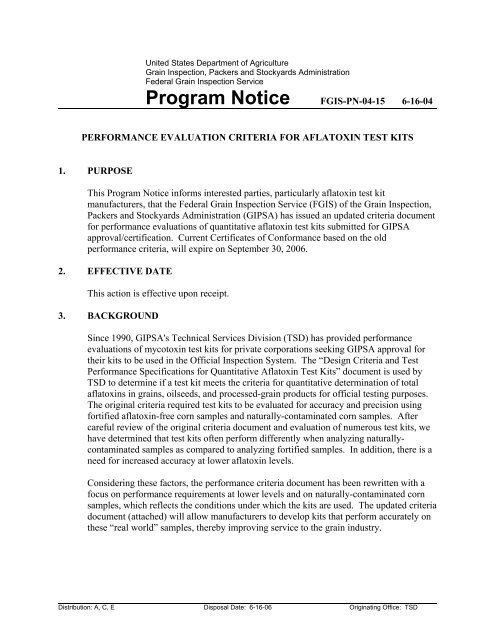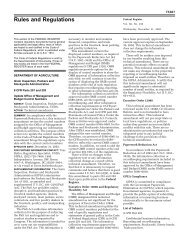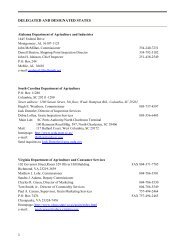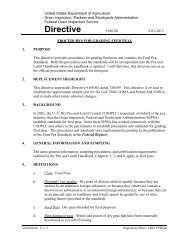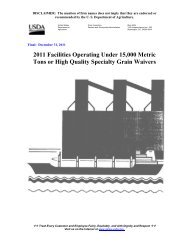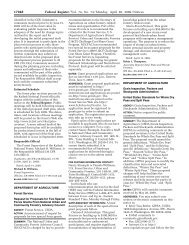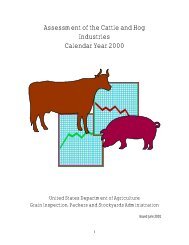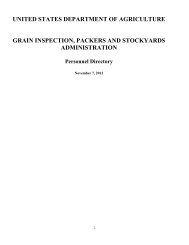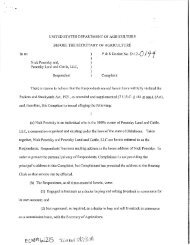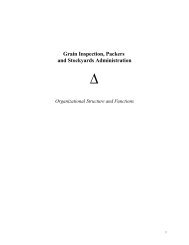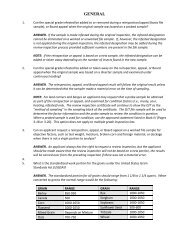Program Notice - Grain Inspection, Packers & Stockyards ...
Program Notice - Grain Inspection, Packers & Stockyards ...
Program Notice - Grain Inspection, Packers & Stockyards ...
Create successful ePaper yourself
Turn your PDF publications into a flip-book with our unique Google optimized e-Paper software.
United States Department of Agriculture<br />
<strong>Grain</strong> <strong>Inspection</strong>, <strong>Packers</strong> and <strong>Stockyards</strong> Administration<br />
Federal <strong>Grain</strong> <strong>Inspection</strong> Service<br />
<strong>Program</strong> <strong>Notice</strong> FGIS-PN-04-15 6-16-04<br />
PERFORMANCE EVALUATION CRITERIA FOR AFLATOXIN TEST KITS<br />
1. PURPOSE<br />
This <strong>Program</strong> <strong>Notice</strong> informs interested parties, particularly aflatoxin test kit<br />
manufacturers, that the Federal <strong>Grain</strong> <strong>Inspection</strong> Service (FGIS) of the <strong>Grain</strong> <strong>Inspection</strong>,<br />
<strong>Packers</strong> and <strong>Stockyards</strong> Administration (GIPSA) has issued an updated criteria document<br />
for performance evaluations of quantitative aflatoxin test kits submitted for GIPSA<br />
approval/certification. Current Certificates of Conformance based on the old<br />
performance criteria, will expire on September 30, 2006.<br />
2. EFFECTIVE DATE<br />
This action is effective upon receipt.<br />
3. BACKGROUND<br />
Since 1990, GIPSA's Technical Services Division (TSD) has provided performance<br />
evaluations of mycotoxin test kits for private corporations seeking GIPSA approval for<br />
their kits to be used in the Official <strong>Inspection</strong> System. The “Design Criteria and Test<br />
Performance Specifications for Quantitative Aflatoxin Test Kits” document is used by<br />
TSD to determine if a test kit meets the criteria for quantitative determination of total<br />
aflatoxins in grains, oilseeds, and processed-grain products for official testing purposes.<br />
The original criteria required test kits to be evaluated for accuracy and precision using<br />
fortified aflatoxin-free corn samples and naturally-contaminated corn samples. After<br />
careful review of the original criteria document and evaluation of numerous test kits, we<br />
have determined that test kits often perform differently when analyzing naturallycontaminated<br />
samples as compared to analyzing fortified samples. In addition, there is a<br />
need for increased accuracy at lower aflatoxin levels.<br />
Considering these factors, the performance criteria document has been rewritten with a<br />
focus on performance requirements at lower levels and on naturally-contaminated corn<br />
samples, which reflects the conditions under which the kits are used. The updated criteria<br />
document (attached) will allow manufacturers to develop kits that perform accurately on<br />
these “real world” samples, thereby improving service to the grain industry.<br />
Distribution: A, C, E Disposal Date: 6-16-06 Originating Office: TSD
4. QUESTIONS<br />
Direct questions concerning test performance specifications for quantitative aflatoxin test<br />
kits to Lynn Polston, TSD, at (816) 891-0444; or e-mail at Lynn.A.Polston@usda.gov.<br />
Steven N. Tanner, Director<br />
Technical Services Division<br />
Attachment
DESIGN CRITERIA AND TEST PERFORMANCE SPECIFICATIONS<br />
FOR QUANTITATIVE AFLATOXIN TEST KITS<br />
Prepared by<br />
U.S. Department of Agriculture<br />
<strong>Grain</strong> <strong>Inspection</strong>, <strong>Packers</strong> and <strong>Stockyards</strong> Administration<br />
Technical Services Division<br />
Approved By: __________________________________<br />
Group Leader, Test Kit Evaluation <strong>Program</strong><br />
June 8, 2004<br />
Date:_____________________<br />
Approved By: __________________________________<br />
Branch Chief, ARTS<br />
June 8, 2004<br />
Date:_____________________
Attachment 1 Page 2<br />
APPROVAL FACTORS<br />
Each offeror must provide documentation to show that their test kit is capable of meeting all of<br />
the performance standards for quantitative test kits listed below. In addition, the <strong>Grain</strong><br />
<strong>Inspection</strong>, <strong>Packers</strong> and <strong>Stockyards</strong> Administration (GIPSA) will verify that the test kit meets<br />
these performance standards.<br />
Definitions<br />
Corn Germ Meal - Ground germ cake from which part of the oil has been pressed.<br />
Corn Gluten Feed - Residue of the corn kernel after most of the starch, gluten, and germ has been<br />
removed by wet milling.<br />
Corn Gluten Meal - Finely ground corn gluten feed.<br />
Corn Meal - Finely ground, unsifted corn.<br />
Corn/Soy Blend - Blend of corn meal, defatted soybean meal, mineral mix, and soybeans<br />
(refined and stabilized). The ratios are approximately 26:8:1:2, respectively.<br />
Corn Flour - Finely ground corn meal.<br />
Corn Bran - Outer coating of the corn kernel.<br />
Flaking Corn Grits - A portion of the corn endosperm is isolated, processed through a<br />
degerminator, dried, cooled, and sifted.<br />
Distillers Dried <strong>Grain</strong> - The product obtained after the removal of ethanol by distillation from the<br />
yeast fermentation of a grain or a grain mixture by separating the resultant coarse grain<br />
fraction of the whole stillage and drying it.<br />
Distillers Dried <strong>Grain</strong> w/Solubles - The product obtained after the removal of ethanol by<br />
distillation from the yeast fermentation of a grain or grain mixture by condensing and<br />
drying at least ¾ of the solids.<br />
Condensed Distillers Solubles - The product obtained after the removal of ethanol by distillation<br />
from the yeast fermentation of a grain or a grain mixture by condensing the thin stillage<br />
fraction to a semi-solid.<br />
Fortified Samples - Samples containing known, added amounts of pure aflatoxin standards.<br />
Test Kit - A commercially packaged system of the principal or key components of an analytical<br />
method used to determine the presence of a specific analyte(s) in a given matrix(es). Test<br />
kits include directions for their use and are self-contained, complete analytical systems,<br />
but they may require supporting supplies and equipment. The key components frequently<br />
represent proprietary elements or reagents that may be readily prepared only by the<br />
producer of the kit.
Attachment 1 Page 3<br />
Reference Method - Refers to the GIPSA aflatoxin reference method entitled, “HPLC Reference<br />
Method for the Determination of Aflatoxins in Corn, Distillers Dried <strong>Grain</strong>s, and Corn<br />
Gluten Feed.” This document is available upon request.<br />
Performance Standards<br />
Good Laboratory Practices. Good laboratory procedures must be followed when conducting<br />
experiments to acquire data to submit in support of specific test kit performance. The same<br />
person performing the analyses must not prepare the fortified samples. All samples must be<br />
labeled with a code and fully randomized so that the analyst conducting the test cannot know the<br />
level of analyte. Aflatoxin concentrations must be confirmed by UV spectrophotometry as<br />
specified in the Reference Method. A certificate of analysis (purity >98%) from the supplier of<br />
each aflatoxin standard shall be submitted with the data.<br />
1. Time required for completion of an analysis.<br />
A test kit must be capable of quantifying aflatoxin residues in a single, pre-ground sample in less<br />
than 30 minutes. For example, a test that would require two hours for the extraction and<br />
simultaneous analysis of four samples would not be acceptable. If the standards supplied with<br />
the test kit do not cover the range specified, the total time for completing a sample analysis,<br />
including dilutions, must meet the thirty-minute requirement.<br />
2. The limit of detection (LOD) of offered test kits must be less than or equal to 3.0 ppb.<br />
The LOD is defined as follows: LOD = mean + 2 *( SD). The mean is determined from readings<br />
of 10 different extracts of an aflatoxin-free sample and SD is the standard deviation of those 10<br />
readings. Offerors must provide the LOD for their test kits. Test kits not meeting the LOD<br />
requirement for corn will not be considered for approval. LOD determinations shall be made<br />
on each commodity for which the test kit is seeking approval.<br />
3. Comparative accuracy of test kits on corn samples naturally contaminated with<br />
aflatoxin.<br />
Four corn samples naturally contaminated with aflatoxins at 5, 10, 20, and 100 ppb (±15%) shall<br />
be ground so that 95% of the material passes through a 20-mesh sieve. The corn sample at each<br />
concentration level will be divided into forty-two sets of 50-g sub portions using a method that<br />
will ensure that resultant sub portions are well mixed and homogeneous. These sub portions will<br />
be placed in specimen containers, sealed, and stored at 5 o C until needed.<br />
Three analysts shall each extract seven sub portions of the sample at each level according to test<br />
kit instructions. One analysis of each extract shall be made by each of three operators. Each<br />
operator shall use a separate kit for his or her analyses. No sharing of test kits will be allowed.<br />
In addition, twenty-one sub portions of this sample will be extracted and analyzed by HPLC in<br />
three separate batches (seven samples per batch) using the GIPSA Reference Method.
Attachment 1 Page 4<br />
At least 95% of the individual values at each concentration must be within the applicable range<br />
as specified in Table 1.<br />
Concentration<br />
(ppb)<br />
Maximum<br />
RSD i<br />
(%)<br />
Table 1. Acceptable Limits<br />
Standard<br />
Deviation<br />
Range*<br />
(ppb)<br />
5.0 30 1.5 2.0 – 8.0<br />
10 30 3.0 4.0 – 16<br />
20 25 5.0 10 – 30<br />
100 25 25 50 – 150<br />
* For naturally contaminated samples, this range will be recalculated using the actual mean and<br />
the maximum RSD values at each concentration as listed. The mean will be determined by using<br />
the 21 HPLC values obtained using GIPSA's Aflatoxin Reference Method.<br />
4. Suggested additional commodities: corn meal, corn gluten feed, corn germ meal, corn<br />
gluten meal, corn/soy blend, rice, milled rice, sorghum, wheat, corn flour, corn bran,<br />
rough rice, and flaking corn grits, distillers dried grains, distillers dried grains w/<br />
solubles, and condensed distillers solubles.<br />
For a test kit to be approved for additional commodities, offerors must submit procedures and<br />
documented data showing accuracy of tests for each commodity. Uncontaminated samples of<br />
each commodity must be ground with a mill so that over 95% of the material passes through a<br />
20-mesh sieve. Ground portions must be divided into 50-g sub portions using a method that will<br />
ensure that resultant sub portions are well mixed and homogenous. Specific information on the<br />
equipment and procedures that were used in the grinding, mixing, and sieving processes must be<br />
provided.<br />
A minimum of five fortified samples for each matrix at 5 ppb and a minimum of five fortified<br />
samples for each matrix at 20 ppb total aflatoxins (B1+B2+G1+G2) should be prepared using<br />
confirmed standards (as described in Good Laboratory Practices) that contains B1, B2, G1, and G2<br />
in the ratio of 10:1:1:1, respectively. Samples should be left open in an exhaust hood for 30<br />
minutes after fortification and stored at 5 o C until analyzed.<br />
One operator shall extract samples according to test kit instructions. For each and every matrix,<br />
a single analyst shall perform one analysis of each extract using the appropriate test kit materials<br />
including needed equipment not contained in the test kit. All analyses shall be conducted at<br />
room temperature. Controls shall be used with each individual analysis if required by the<br />
instructions for the test kit.<br />
At least 95% of the individual values at each concentration must be within the applicable range<br />
as specified in Table 1.
Attachment 1 Page 5<br />
5. Avoidance of toxic or hazardous substances.<br />
Testing shall not expose employees to toxic or hazardous substances higher than OSHA<br />
Standards (29 CFR) or require special waste disposal. Items that might require special waste<br />
disposal include all radioactive materials, materials containing concentrations of substances that<br />
exceed the Environmental Protection Agency (EPA) Maximum Concentrations of Contaminants<br />
for the Toxicity Characteristic found in 40 CFR, and any materials having the EPA Hazardous<br />
Waste Number D003 as defined in 40 CFR. Material Safety Data Sheets shall be provided for<br />
each test kit. Each offeror must provide information on waste disposal that meets EPA<br />
requirements for all chemicals used in their test kit. No test kit will be considered for approval<br />
that cannot meet the above criteria.<br />
6. Sensitivity to Electromagnetic Fields<br />
Electronic equipment offered with test kits shall be insensitive to electromagnetic fields of<br />
intensity of 5.0 volts/meter over the frequency range of 500 KHz to 1 GHz and less than or equal<br />
to 1.0 volt/meter over a frequency range of 1.1 GHz to 15 GHz. Offerors shall provide a<br />
statement of certification from an accredited laboratory to this effect in their proposal.<br />
Laboratories shall be accredited under the National Volunteer Laboratory Accreditation <strong>Program</strong><br />
operated by the National Institute of Standards and Technology, Gaithersburg, Maryland. Any<br />
electronic equipment not meeting this requirement will not be considered for approval.<br />
7. Temperature sensitivity.<br />
One naturally contaminated corn sample at 20 ppb (±15%) total aflatoxin concentration shall be<br />
prepared by grinding so that 95% of the material passes a 20-mesh sieve. The corn sample shall<br />
be divided into seven 50-g sub portions using a method that will ensure that the resultant sub<br />
portions are homogenous. These sub portions will be placed in specimen containers, sealed, and<br />
stored at 5 o C until needed.<br />
One operator shall extract each sample at room temperature according to test kit instructions.<br />
Extracted samples must be protected from light during this test.<br />
Place extracts and all equipment needed to conduct the analysis in an environmental chamber set<br />
at 24 o C. Allow to equilibrate for a period of one hour. Perform assays using manufacturer's<br />
recommended procedure.<br />
Adjust the room temperature to 18 o C and allow extracts and equipment to equilibrate for one<br />
hour. Perform assays using manufacturer's recommended procedure.<br />
Readjust the temperature of the environmental chamber to 30 o C and allow extracts and<br />
equipment to equilibrate for one hour. Perform assays using manufacturer's recommended<br />
procedure.<br />
At least 95% of the individual values must be within the applicable range as specified in Table 1.
Attachment 1 Page 6<br />
8. Stability.<br />
Offerors must provide data on the stability of their materials and reagents used in their tests<br />
under label-recommended storage times and conditions that support claimed expiration dating<br />
and lot-to-lot variability. This data should confirm conformance to all applicable criteria in this<br />
document.<br />
9. GIPSA Performance Verification on Naturally Contaminated Samples.<br />
Offerors will be required to supply all test kits, equipment, and supplies needed to complete the<br />
verification tests described below.<br />
Two corn samples naturally contaminated with total aflatoxin concentrations of approximately 5<br />
and 20 ppb will be ground to meet the sieve specifications given in Section 3. The ground<br />
sample will be mixed and divided into forty-two sets of 50-g sub portions. These sub portions<br />
will be placed in specimen containers, sealed, and stored at 5 o C until needed.<br />
Three analysts shall each extract seven sub portions at each level according to test kit<br />
instructions. One analysis of each extract will be made by each of the three operators. In<br />
addition, twenty-one sub portions of the sample at each level, will be extracted and analyzed by<br />
HPLC in three separate batches (seven samples per batch) using the GIPSA Reference Method.<br />
For GIPSA approval, at least 95% of the individual values at each concentration must be within<br />
the range as specified in Table 1.<br />
Sample Extraction and Analyses. Sample extraction and analyses will be done according to the<br />
offeror's directions. All analyses will be conducted at room temperature (approximately 21 o C).<br />
If a control is required for the test, then a control will be used with each individual sample<br />
analysis.<br />
Operators and Training. Three operators will conduct all analyses. All operators shall receive<br />
up to two days of training in the use of each test kit. The training is to be provided by the<br />
offeror. In addition, each operator shall receive detailed, step-by-step, written directions,<br />
prepared by the offeror, on the use of each test kit.<br />
Outliers. If an observation is a suspected outlier, the available documentation will be reviewed<br />
to identify the source of the error and make corrections where possible. Identifiable errors (not<br />
the fault of the test method) that cannot be corrected will result in the observation being<br />
discarded. Suspected outliers with unidentifiable causes will be tested using methods described<br />
in the AOAC manual, "Use of Statistics to Develop and Evaluate Analytical Methods," by G. T.<br />
Wernimont (p. 96 and Table A-8). No more than one outlier per test kit will be discarded.
Attachment 2 Page 1<br />
PROTOCOL & NOTIFICATION AGREEMENT STATEMENT<br />
This is to certify that I am an Official Representative of ,<br />
that I fully understand the conditions which GIPSA will use to determine if our quantitative<br />
aflatoxin test kit marketed under the trade name<br />
___________________________________________________________ will be given a<br />
Certificate of Conformance for use in the official inspection system. The Certificate of<br />
Conformance will be valid for three years from the date it is issued.<br />
GIPSA monitors the performance of all approved test kits, and reserves the right to conduct a<br />
performance verification of the test kit based on data obtained through GIPSA’s quality<br />
assurance programs. I understand that if the kit fails to meet the criteria set forth in the<br />
performance specification document, the Certificate of Conformance will be revoked<br />
immediately. I further understand that the Certificate of Conformance will expire after three<br />
years and the kit must be completely re-evaluated to renew the Certificate of Conformance. I<br />
accept these conditions and I also agree to abide by the Manufacturer's Notification<br />
Responsibilities provided in this document.<br />
Name<br />
Date<br />
________________________<br />
___________________________________________<br />
Title
Attachment 2 Page 2<br />
Manufacturer's Notification Responsibilities<br />
Manufacturers with test kits on the list of equipment approved for official inspection must notify<br />
the Director, Technical Services Division, USDA-GIPSA Technical Center, 10383 N.<br />
Ambassador Drive, Kansas City, Missouri 64153-1394, in writing when any changes or<br />
alterations are made to the approved test kit, to any reagents, to the kit shelf life, to equipment<br />
used in the test kit, or to any part of the analytical method. Any alterations to a test kit will<br />
require a full GIPSA performance verification. Failure to notify GIPSA of these changes will<br />
serve as grounds for immediate withdrawal of the test kit from the approved list. Changes in the<br />
packaging, brochure, or other marketing information about the test kit are exempt from this<br />
requirement.


